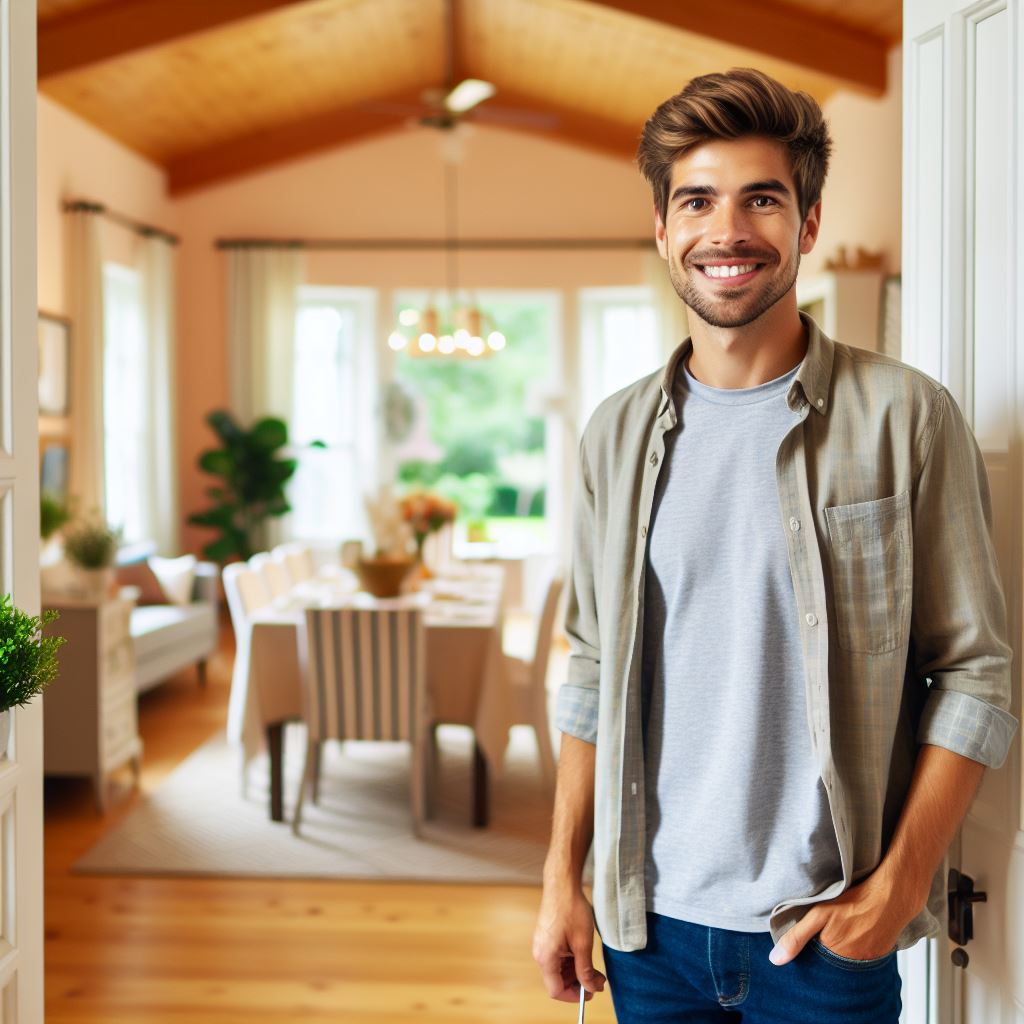Introduction
Open houses play a crucial role in the real estate industry as they provide a unique opportunity for potential buyers to experience a property firsthand.
This blog post aims to serve as a comprehensive guide for organizing a successful open house event.
In the competitive world of real estate, open houses can make all the difference.
They allow buyers to visualize themselves in the space, better understand the layout, and get a feel for the neighborhood.
Therefore, it is essential to ensure that your open house event is well-planned and executed.
This blog post will walk you through the key elements of organizing a successful open house.
From initial preparations to creating an inviting atmosphere, the steps outlined here will help you maximize your chances of selling the property.
We will discuss various aspects such as staging and cleaning, setting the right date and time, utilizing effective marketing strategies, and of course, interacting with potential buyers during the event.
Each of these elements plays a vital role in the overall success of your open house.
By following this guide, you will have the necessary tools and knowledge to organize a truly impressive open house that will leave a lasting impression on potential buyers.
So let’s dive in and explore the ins and outs of achieving open house success!
Remember, a well-executed open house can make a significant difference in selling a property quickly and at a desirable price.
Preparing for the Open House
Setting a date and time that aligns with target audience
When preparing for an open house, it is crucial to select a date and time that suits the target audience.
By doing so, you will increase the chances of attracting potential buyers who are genuinely interested in the property.
Thoroughly cleaning and decluttering the property
One of the essential tasks in preparing for an open house is to ensure that the property is clean and clutter-free.
A thorough cleaning will create a positive first impression and make the home more appealing to potential buyers.
Staging the home effectively to showcase its best features
Effective home staging can significantly impact the success of an open house.
Emphasize the property’s best features by arranging furniture, adding tasteful decor, and creating a welcoming atmosphere that allows potential buyers to envision themselves living there.
Creating appealing marketing materials, such as brochures and virtual tours
To attract potential buyers before the open house, it is crucial to create appealing marketing materials. This includes well-designed brochures that highlight the property’s key features and virtual tours that provide a comprehensive view of the home.
When setting a date and time for the open house, consider the target audience’s availability and preferences.
Thoroughly clean the property, paying attention to every detail, from walls to floors, ensuring it is spotless.
Declutter the home by removing personal items and excess furniture, maximizing space and allowing potential buyers to envision themselves living there.
Effectively stage the home by arranging furniture in an appealing manner, using tasteful decor, and creating a warm and inviting ambiance.
Create attractive marketing materials, such as brochures, that showcase the property’s unique selling points and capture potential buyers’ attention.
Utilize virtual tours to provide potential buyers with a comprehensive and immersive experience of the home’s layout and features.
Make sure the marketing materials are visually appealing and informative, using high-quality images and accurate descriptions.
Consider partnering with professional photographers or videographers to create eye-catching virtual tours that showcase the property in the best possible light.
Incorporate key information, such as the property’s square footage, number of bedrooms and bathrooms, and any additional amenities or unique selling points.
Ensure that the brochures and virtual tours are easily accessible and shareable through various online platforms, such as the real estate agency’s website and social media channels.
Regularly update the marketing materials to reflect any changes or updates to the property, ensuring they remain current and accurate.
By following these steps and thoroughly preparing for the open house, you increase the likelihood of attracting potential buyers and ultimately achieving a successful sale.
Take the time to plan and execute each aspect with care, as the success of the open house can greatly impact the sale of the property.
Read: Closing Techniques Every Realtor Must Know
Spreading the Word
Utilizing various online platforms to promote the open house
When it comes to promoting an open house, online platforms are your best friends.
Take advantage of social media platforms such as Facebook, Instagram, and Twitter to spread the word about your upcoming event.
Create visually appealing posts featuring high-quality photos of the property and include important details such as the date, time, and location of the open house.
Encourage your friends, family, and colleagues to share your posts to reach a wider audience.
Additionally, consider creating a dedicated event page on Facebook where interested individuals can RSVP and receive updates about the open house.
Encourage people to invite their friends who might be in the market for a new home.
Don’t limit yourself to just social media platforms – explore other online options.
Websites such as Craigslist, Zillow, and local real estate portals often have sections dedicated to open house listings.
Make sure to create engaging descriptions and upload captivating photos to attract potential visitors.
Contacting local real estate agents and brokers to inform them about the event
Real estate agents and brokers can be valuable allies when it comes to spreading the word about your open house.
Reach out to local professionals in your area and inform them about the event.
Send personalized emails or make phone calls to explain the details of the open house, emphasizing any unique features or selling points of the property.
Provide them with flyers or digital promotional materials that they can forward to their own client base.
Consider offering real estate agents and brokers who bring their clients to the open house a small incentive, such as a gift card or a referral fee.
This can motivate them to actively promote the event and bring potential buyers.
Placing eye-catching signs and banners in strategic locations to attract passersby
Never underestimate the power of physical signage. Placing eye-catching signs and banners in strategic locations around the neighborhood can attract the attention of passersby who may not have seen your online promotions.
Make sure the signs are well-designed and clearly display the date, time, and location of the open house.
Use bright colors and large fonts to catch the eye from a distance.
Strategic locations for your signs include busy intersections, near community centers, and in front of the property itself.
Consider reaching out to local businesses and asking if you can place signs on their premises, leveraging their existing foot traffic.
Don’t forget to include directional arrows on your signs, guiding interested individuals towards the open house location.
This will make it easier for people to find the property and increase the chances of attendance.
By utilizing various online platforms, contacting local real estate professionals, and placing eye-catching signs, you can effectively spread the word about your open house, attracting a larger pool of potential buyers and ensuring a successful event.
Read: The Art of Closing in Real Estate Explained
Welcoming Visitors
Greeting each visitor with a warm and friendly attitude
As the doors swing open for your open house event, remember that first impressions matter.
A warm and friendly greeting sets the tone for the entire experience.
Make eye contact, offer a genuine smile, and extend a welcoming hand to every visitor.
Personalized greetings go a long way, so consider using their names if possible.
This small effort creates an immediate connection, making guests feel valued and at ease.
Encouraging visitors to sign in and providing them with information packets
After the initial greeting, guide visitors to the sign-in area.
Encourage them to register by providing their contact information and any specific interests they may have in the property.
This not only helps you follow up with potential leads but also tailors your future communications to their preferences.
To enhance their experience, offer information packets containing essential details about the property, neighborhood, and amenities.
Include a map highlighting key points of interest, a schedule of the day’s events, and a brief introduction to the property’s unique features.
This proactive approach keeps visitors engaged and informed, showcasing your commitment to their needs.
Offering refreshments to create a comfortable atmosphere
Create a cozy and inviting atmosphere by offering refreshments.
A well-placed refreshment station, stocked with beverages and snacks, encourages visitors to linger and engage in conversations.
This informal setting allows for more relaxed discussions, providing you with the opportunity to address any questions and build rapport.
Consider incorporating a themed touch, such as locally sourced snacks or a signature drink, to make the experience even more memorable.
The goal is to create an environment where potential buyers feel comfortable envisioning themselves in the space.
In summary, welcoming visitors effectively involves a combination of warmth, efficiency, and thoughtful touches.
By implementing these steps, you not only enhance the overall open house experience but also increase the likelihood of leaving a lasting positive impression on potential buyers.
Read: The Ethical Agent: Selling with Integrity

Guided Tour
Brief introduction about the property’s key features and highlights
During the open house, it is essential to start the guided tour by presenting a brief introduction about the property’s key features and highlights.
This introduction should capture the attention of the visitors and make them eager to explore further.
Begin the tour by pointing out the major selling points of the property.
Highlight any unique features or upgrades that set it apart from other homes in the area.
Talk about the spacious layout, modern amenities, or stunning views, emphasizing what makes this property special.
Use descriptive language to paint a vivid picture of what life would be like in this home.
Talk about the luxurious master suite, the gourmet kitchen, or the inviting outdoor space that is perfect for entertaining.
Make sure to mention any recent renovations or upgrades that have been done to the property.
Guiding visitors through each room, highlighting the unique aspects
Once you have presented the initial introduction, guide the visitors through each room of the property, highlighting the unique aspects of each space.
Start with the main living areas, such as the living room, dining room, and kitchen.
Point out any architectural details, such as vaulted ceilings, custom moldings, or hardwood floors.
Highlight the natural light that fills the rooms and emphasize the functional layout that makes the space perfect for everyday living and entertaining.
As you move from room to room, invite visitors to imagine themselves living in the space.
Encourage them to picture their furniture in the rooms and visualize how they would utilize each area.
Showcase any built-in storage solutions or innovative design features that add both functionality and style.
Answering questions and providing additional information when necessary
Throughout the guided tour, be prepared to answer any questions that visitors may have and provide additional information when necessary.
This is an excellent opportunity to address any concerns or doubts that potential buyers might have.
Listen attentively to the questions and feedback from the visitors.
This will help you better understand their needs and preferences, allowing you to tailor your responses accordingly.
If someone asks about the age of the roofing or the condition of the HVAC system, provide honest and accurate answers.
If visitors express interest in specific features or amenities, elaborate on them and explain how they add value to the property.
Share any relevant information about the neighborhood, such as nearby schools, parks, or shopping centers.
If there are any community amenities, such as a pool or clubhouse, make sure to highlight those as well.
In addition to answering questions, be proactive in providing additional information.
Offer brochures or flyers with details about the property that visitors can take home with them.
Provide contact information for the listing agent or any other relevant parties in case visitors have further questions after the open house.
By presenting a brief introduction about the property’s key features and highlights, guiding visitors through each room while highlighting the unique aspects, and answering questions and providing additional information when necessary, you can successfully conduct a guided tour during an open house.
This will allow potential buyers to get a better understanding of the property and help them envision themselves living there.
Read: Real Estate: Strategies for Effective Closings
Fostering Connections
Building professional relationships with potential buyers
In the intricate dance of an open house event, success lies not just in presenting a property but in establishing genuine connections with potential buyers.
The art of building professional relationships begins with a warm welcome.
Greet visitors with a smile, creating an inviting atmosphere that sets the stage for meaningful interactions.
Share your enthusiasm for the property, providing insights that showcase your expertise.
Engaging potential buyers involves more than showcasing features; it’s about understanding their needs.
Take the time to ask questions, seeking to uncover what aspects of the property align with their desires.
Whether it’s the spacious kitchen, the cozy fireplace, or the vibrant neighborhood, connecting on a personal level fosters a sense of trust and mutual understanding.
Engaging in conversation and actively listening to visitors’ needs and preferences
As the open house unfolds, engage in conversations that go beyond the surface.
Actively listen to visitors’ needs and preferences, showing genuine interest in their vision for a dream home.
This attentiveness not only helps tailor your presentation but also creates a lasting impression.
Highlight features that align with their stated preferences, turning the property tour into a personalized experience.
Be prepared to answer questions and address concerns, demonstrating your knowledge and commitment to providing valuable information.
Share success stories or relevant market insights to build credibility.
This approach not only showcases your professionalism but also positions you as a trusted advisor throughout the home-buying process.
Collecting and following up with contact information of interested parties
Seize the opportunity to collect contact information from interested parties.
Implement a streamlined process, whether through sign-up sheets, digital forms, or business cards.
Promptly follow up with personalized messages expressing gratitude for their visit and reiterating the key features discussed.
Maintain a proactive approach by sharing additional details, exclusive insights, or even personalized property recommendations based on their preferences.
This follow-up not only reinforces your commitment but also keeps you top of mind when they decide to make a move.
In the journey from the initial welcome to the follow-up, fostering connections proves pivotal.
Beyond showcasing the property, it’s about building relationships that endure beyond the open house, turning potential buyers into valued clients.
Closing the Open House
As the day draws to a close, it’s crucial to wrap up your open house on a positive note, leaving a lasting impression on potential buyers.
Follow these essential steps to ensure a successful closing:
Thanking Visitors for Attending and Expressing Gratitude
As the last visitors meander through the property, take a moment to express genuine gratitude for their attendance.
A simple, heartfelt thank-you goes a long way in creating a positive atmosphere.
Use this opportunity to emphasize your appreciation for their interest in the property, acknowledging the time they invested in exploring the space.
Consider setting up a designated area near the exit with a small sign or banner expressing gratitude.
A warm farewell and a sincere thank-you can leave a memorable impression on visitors, fostering a positive connection with both you and the property.
Handing Out Business Cards and Encouraging Further Communication
Before visitors leave, ensure they have your business card in hand.
Personalize the exchange by noting specific aspects of the property they found appealing.
This not only reinforces their positive experience but also provides a tangible reminder of your engagement.
Encourage further communication by inviting them to reach out with any questions or thoughts.
Emphasize your commitment to assisting them in their home-buying journey.
A well-timed follow-up can make the difference between a fleeting visit and a potential sale.
Evaluating the Event for Future Improvement
As the last visitor departs, take a moment to reflect on the overall success of the open house.
Evaluate the turnout, the level of engagement, and any feedback received during the event.
Identifying areas for improvement is essential for refining your approach in future open houses.
Consider creating a brief survey for attendees to gather valuable insights.
Analyze the data to pinpoint strengths and areas that require enhancement.
This reflective process ensures continuous growth and refinement, setting the stage for even more successful open houses in the future.
All in all, closing the open house with gratitude, providing contact information, and evaluating the event are critical steps in solidifying connections with potential buyers and refining your approach for future endeavors.
Conclusion
A well-executed open house is essential in the real estate market, as it can significantly impact the success of a property sale.
By summarizing the key steps from start to finish for a successful open house experience, readers can apply the outlined tips and techniques to enhance their own open house results.
Throughout this blog post, we have highlighted the importance of thorough planning and preparation.
From staging the property to creating an inviting atmosphere, each step plays a crucial role in attracting potential buyers and increasing their interest in the property.
Furthermore, we have emphasized the significance of effective marketing strategies.
Utilizing various platforms, such as social media and online listings, can expand the reach of the open house event and generate more leads.
Additionally, creating visually appealing promotional materials and optimizing online listings can attract a larger number of potential buyers.
During the open house, engaging with visitors and providing comprehensive information about the property is crucial.
By being readily available to answer questions and addressing any concerns, real estate agents can build trust and credibility, ultimately increasing the chances of a successful sale.
Finally, we have discussed the importance of collecting feedback from visitors.
This valuable information can provide insights into the strengths and weaknesses of the property, allowing real estate agents to make necessary improvements and adjustments for future open houses.
In the end, by following the key steps and utilizing the tips and techniques outlined in this blog post, real estate professionals can optimize their open house results and increase their chances of achieving a successful property sale.
With thorough planning, effective marketing, engaging with visitors, and utilizing feedback, the potential for a successful open house experience is significantly enhanced.




